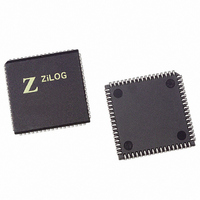Z16C3516VSG Zilog, Z16C3516VSG Datasheet - Page 42

Z16C3516VSG
Manufacturer Part Number
Z16C3516VSG
Description
IC 16MHZ Z8500 CMOS ISCC 68-PLCC
Manufacturer
Zilog
Series
IUSC™r
Specifications of Z16C3516VSG
Controller Type
Serial Communications Controller (SCC)
Interface
USB
Voltage - Supply
4.75 V ~ 5.25 V
Current - Supply
50mA
Operating Temperature
0°C ~ 70°C
Mounting Type
Surface Mount
Package / Case
68-LCC (J-Lead)
Lead Free Status / RoHS Status
Lead free / RoHS Compliant
Other names
269-4690-5
Z16C3516VSG
Z16C3516VSG
Available stocks
Company
Part Number
Manufacturer
Quantity
Price
Company:
Part Number:
Z16C3516VSG
Manufacturer:
INTEL
Quantity:
6 219
- Current page: 42 of 268
- Download datasheet (3Mb)
Z16C35ISCC™ User’s Manual
Data Communication Modes
4.3 BYTE-ORIENTED SYNCHRONOUS MODE (Continued)
Start and stop bits are not required in synchronous modes.
All bits are used to transmit data. This eliminates the
“waste” characteristic of asynchronous communication.
4.3.1 Byte Oriented Synchronous Transmit
Once Synchronous mode has been selected, any of three
sync character lengths may be selected:
The 6-bit option Sync character is selected by setting bits
4 and 5 of WR4 to zeros and bit 0 of WR10 to one. Only
the least significant six bits of WR6 are transmitted.
The 8-bit sync character is selected by setting bits 4 and 5
of WR4 to zeros and bit 0 of WR10 to zero. With this option
selected, the transmitter sends the contents of WR6 when
it has no data to send.
Monosync and Bisync modes require clocking information
to be transmitted along with the data either by a method of
encoding data that contains clocking information, or by a
modem that encodes or decodes clock information in the
modulation process. Refer to the Monosync message for-
mat as shown in Figure 4-4.
4-8
6-bit
8-bit
16-bit
Modem Clock
Bit State
Data
Bit
LSB
Figure 4-4. Monosync Data Character Format
1
0
1 1 0
2 3 4
Sync Character
1 0
5 6
1 Bit Time
0 0
7 8
The Bisync mode of operation is similar to the Monosync
mode, except that two sync characters are provided in-
stead of one. Bisync attempts a more structured approach
to synchronization through the use of special characters
as message “headers” or “trailers”.
External Sync mode eliminates the use of sync characters
in the serial data stream by providing an external sync sig-
nal to mark the beginning of a data field; i.e., an external
input pin (Sync) waits for an active state change to indicate
the beginning of an information field.
Character-oriented mode is selected by programming bits
D3 and D2 of WR4 with zeros. This selects synchronous
mode, as opposed to asynchronous mode, but this selec-
tion is further modified by bits 5 to 7 of WR4 as well as bits
1 and 0 of WR10. In sync character-oriented modes, ex-
cept External Sync mode, the state of bits 7 and 6 of WR4
are always forced internally to zeros. In external sync
mode, these two bits must be programmed as described in
Section 5.4.5.
1 1
9 10 11 12 13 . . .
0 1
Data Character
0 1
0 1
UM011001-0601
Related parts for Z16C3516VSG
Image
Part Number
Description
Manufacturer
Datasheet
Request
R

Part Number:
Description:
CMOS ISCC INTEGRATED SERIAL COMMUNICATIONS CONTROLLER
Manufacturer:
ZILOG [Zilog, Inc.]
Datasheet:

Part Number:
Description:
Communication Controllers, ZILOG INTELLIGENT PERIPHERAL CONTROLLER (ZIP)
Manufacturer:
Zilog, Inc.
Datasheet:

Part Number:
Description:
KIT DEV FOR Z8 ENCORE 16K TO 64K
Manufacturer:
Zilog
Datasheet:

Part Number:
Description:
KIT DEV Z8 ENCORE XP 28-PIN
Manufacturer:
Zilog
Datasheet:

Part Number:
Description:
DEV KIT FOR Z8 ENCORE 8K/4K
Manufacturer:
Zilog
Datasheet:

Part Number:
Description:
KIT DEV Z8 ENCORE XP 28-PIN
Manufacturer:
Zilog
Datasheet:

Part Number:
Description:
DEV KIT FOR Z8 ENCORE 4K TO 8K
Manufacturer:
Zilog
Datasheet:

Part Number:
Description:
CMOS Z8 microcontroller. ROM 16 Kbytes, RAM 256 bytes, speed 16 MHz, 32 lines I/O, 3.0V to 5.5V
Manufacturer:
Zilog, Inc.
Datasheet:

Part Number:
Description:
Low-cost microcontroller. 512 bytes ROM, 61 bytes RAM, 8 MHz
Manufacturer:
Zilog, Inc.
Datasheet:

Part Number:
Description:
Z8 4K OTP Microcontroller
Manufacturer:
Zilog, Inc.
Datasheet:

Part Number:
Description:
CMOS SUPER8 ROMLESS MCU
Manufacturer:
Zilog, Inc.
Datasheet:

Part Number:
Description:
SL1866 CMOSZ8 OTP Microcontroller
Manufacturer:
Zilog, Inc.
Datasheet:

Part Number:
Description:
SL1866 CMOSZ8 OTP Microcontroller
Manufacturer:
Zilog, Inc.
Datasheet:

Part Number:
Description:
OTP (KB) = 1, RAM = 125, Speed = 12, I/O = 14, 8-bit Timers = 2, Comm Interfaces Other Features = Por, LV Protect, Voltage = 4.5-5.5V
Manufacturer:
Zilog, Inc.
Datasheet:











